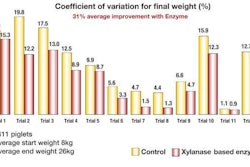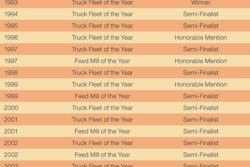Energy costs and equipment efficiency are some of the biggest impacts on operational expenses of feed mills. In this issue, Feed Management takes a look at a few companies' offerings on milling technology available to today's feed manufacturers that are geared to address energy expense and efficiency of operation.
Efficient energy transfer
Less wasted energy is a key attribute of the pellet mills offered today by California Pellet Mill (CPM), according to the company. The manufacturer claims their mills boast positive direct gear drives that provide a 98 percent energy transfer, meaning less energy waste. Other features include a rounded cast gear case with interior ribbing to provide strength and ensures quiet operation. Segmented die clamps eliminate alignment problems and enable quicker die changes, adding to efficiency. The company also states that metal-to-metal seals between components keep dust and steam inside the pelleting chamber and out of the facility environment. A modular gearbox design allows flexibility to increase production with only minor modifications, meaning less down time. CPM also says its replaceable quill flange, a wear item, is designed to save thousands by protecting the quill. The mill's stand-alone oil lubrication system is more effective in maintaining lubrication and keeping the bearings from premature wear, according to company spokespersons. The mill's stainless steel pellet chamber resists corrosion and lasts longer in most pelleting operations. In addition, energy efficiencies can be realized because the single motor is more efficient than dual motors, according to the company. A feeder with multi-positioning capabilities enables easier installation and alignment to bins.
Reduced electrical costs
The Eliminator Hammermill from Bliss Industries promises to increase productivity and profits with a simple design aimed at reducing electrical costs, labor and excessive parts replacements. Features such as internal wear plates, recessed reversible rotor, vortex cutter bar, one-piece plate housing, 3/8" plate doors, octagonal shaped housing, double-drilled rotors and one-piece screen carriage are targeted at maximizing grinding efficiency, according to company spokespersons. The company makes its Eliminator Hammermill available in a wide range of model diameters (19" through 52") and horsepower (5HP - 600HP) configurations, suited to various needs. Each Eliminator purchase is supported with a "post-sales service program" providing continual support services. The Eliminator Hammermill heavy-duty 3/8 in. plate doors hinge left or right as standard equipment so they can be completely removed for greater accessibility. Also all parts of the door lock hinges are secured to the doors or the mill, eliminating loose pieces that could create a safety hazard. The Eliminator is designed to do all the grinding against replaceable wear plates, not against the mill housing. Wear plates are available in different metals for better wearing characteristics and are constructed in two pieces with each half removable from the side doors. The heavy one-piece plate housing decreases the noise level while the octagonal shape creates vortices designed to slow both air and product in the mill. The company says this design improves grinding performance and prolongs hammer and screen life. Bliss mounts the rotor between the bearings with no overhung rotor. Because of the design, the rotor can be removed from the side, without removing the upper mill housing and feeder system. The Vortex Cutter Bar slows the air and product forcing recirculation back into the hammers for more effective grinding and greater capacity on the upside screen.
High feedstuff capacity
The Maxima Hi-Cap Hammermill by Mill Technology Company, Inc., is marketed as providing very uniform particle distribution with a 42 in. diameter for reduce course fractions. It's 42 in. diameter model provides the highest feedstuff capacity available, with claims of surpassing 44 in and 48 in. while maintaining fine grind, according to company spokespersons. The machine's significant 5/8 in. plate body and mass dampened base is designed to provide smooth and quiet operation. It is available in 50 and 60 cycle options ranging from 40 to 400 hp.
Minimum power consumption
The new model 16-4SS Sanitary Rotary Continuous Mixer from Munson Machinery blends ingredients in ratios as extreme as one part per million with 100 percent uniformity regardless of disparities in the bulk densities, particle sizes or flow characteristics of ingredients, which may include liquid additions. Capacity ranges from 85 cu ft/h (2.45 cu m/h) at 1-minute residence time, to 42 cu ft/h (1.19 cu m/h) at 2-minutes residence time. The comapny states that the slowly rotating 16 in. x 4 ft (406 x 1219 mm) cylinder contains proprietary mixing flights that impart a forward- and reverse-pitch, "back flow" mixing action that distributes bulk ingredients thoroughly and gently in short residence times, while eliminating internal restrictions where material could plug or accumulate.
An optional internal stainless steel spray line with spray head allows uniform introduction of a liquid additive to the blended material. The line is suited for spray coating, de-dusting, perfuming, agglomerating and conditioning of materials. The tumbling and cascading effect produced by internal flights is said to achieve 100 percent uniform distribution of liquids with no overspray. Unlike designs that shift masses of material back and forth and distribute weight unevenly, the steadily rotating cylinder reportedly produces a gentle and consistent mixing action using a smaller drive motor of 0.5 HP (.37 kw). RPM may be adjusted to compensate for angles of repose and densities of different mixtures.
The drum angle can be adjusted from 0° to 12° to control product residence time and throughput rate. Solid weirs on the discharge end act as a dam,' allowing materials to build a residence volume' in the machine and overflow the weir. The company says dust-tight diaphragms at both the intake and discharge ends are securely retained against the mixing drum and revolving cylinders, preventing the escape of dust or fumes. Material is fully discharged at the end of a run for rapid sanitizing and changeovers. The mixing drum is supported by heavy-duty nylon or hardened steel "trunnion rollers" that ride on machined "trunnion rings" for minimum power consumption and rapid maintenance.
Low-energy consumption
The Cycone blender by Bolz/Summix is a vertical conical screw blender is a low-energy consumer which easily handles all types of materials to include foods, pellets, and grains, to deliver very quick and precise mixing of batches in a single vessel with non-segregation during discharge. The rotating screw does not have a bottom bearing support, thereby eliminating any dead spots or difficult areas to clean, and allowing for full bore open discharging of the product. Discharge of the material is fast and simple. Rotating with the mixing screw is a spray nozzle which allows the user to inject liquid or gas ingredients into the batch or use this feature for automatic CIP cleaning. For more intense mixing a sidewall mounted lump breaker can be incorporated. The conical mixer design also lends itself to exceptional and fast CIP cleaning. This is fully contained multi-step processing system from product loading, processing and then discharging for a true safe and clean system.
Pic: 0803FMGrind5.jpg
.jpg?auto=format%2Ccompress&crop=faces&fit=crop&h=48&q=70&w=48)


.jpg?auto=format%2Ccompress&fit=crop&h=167&q=70&w=250)

.jpg?auto=format%2Ccompress&fit=crop&h=167&q=70&w=250)












